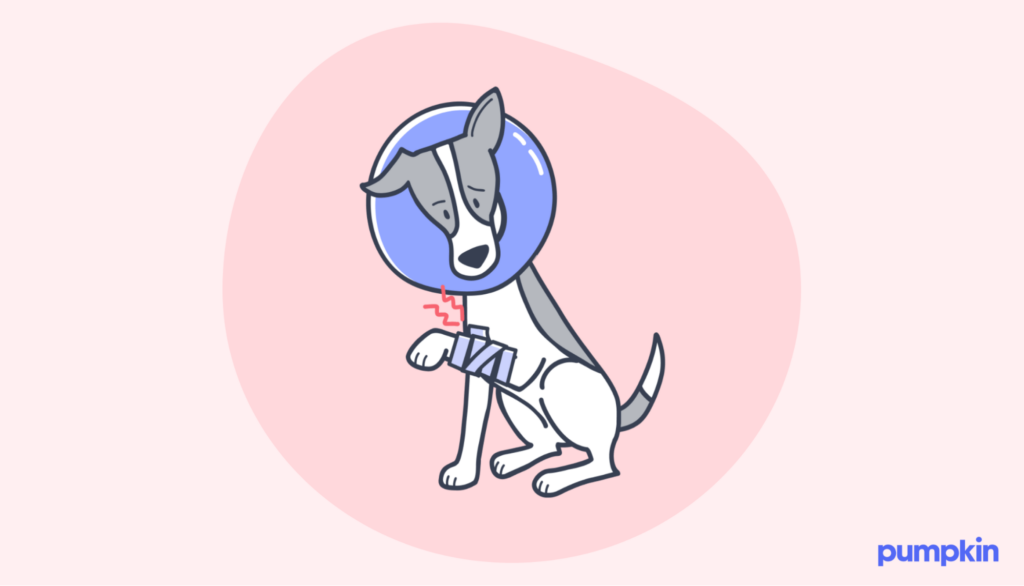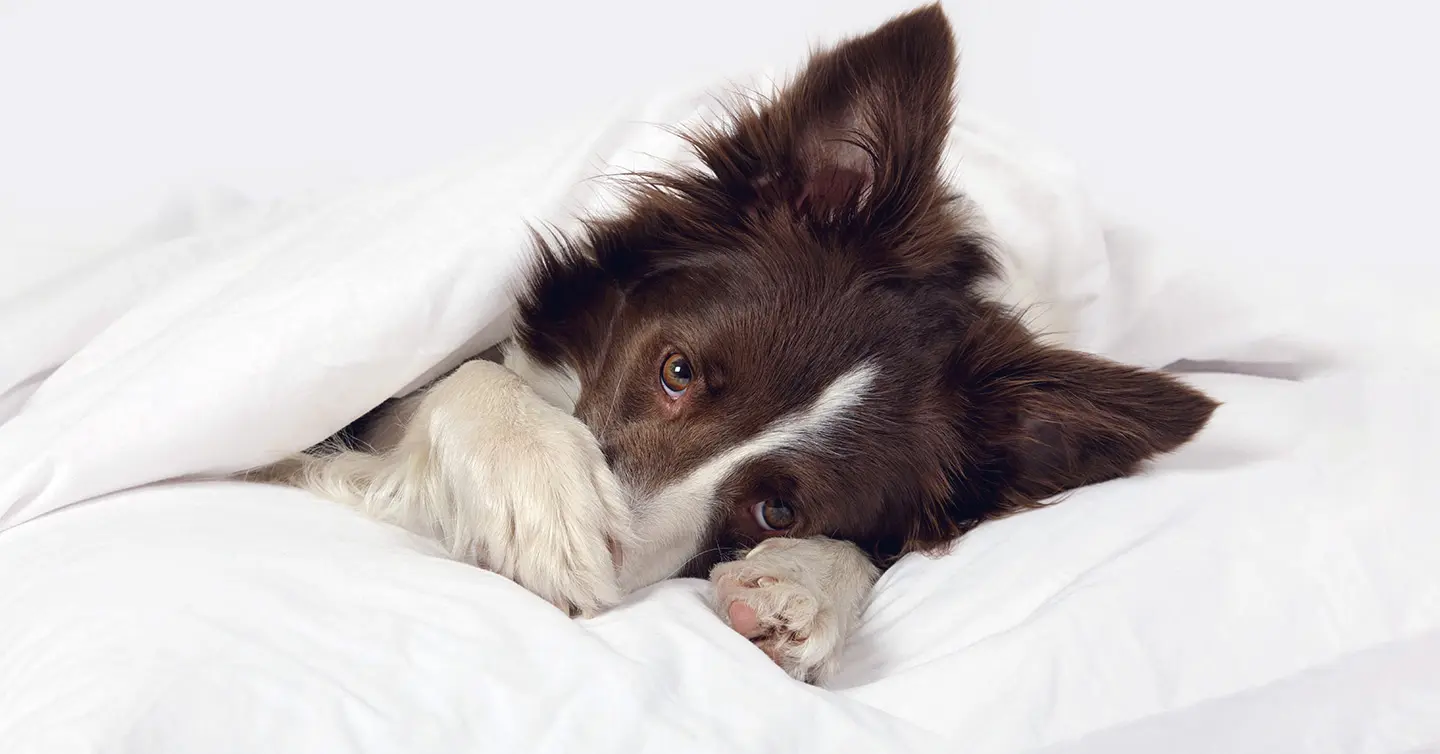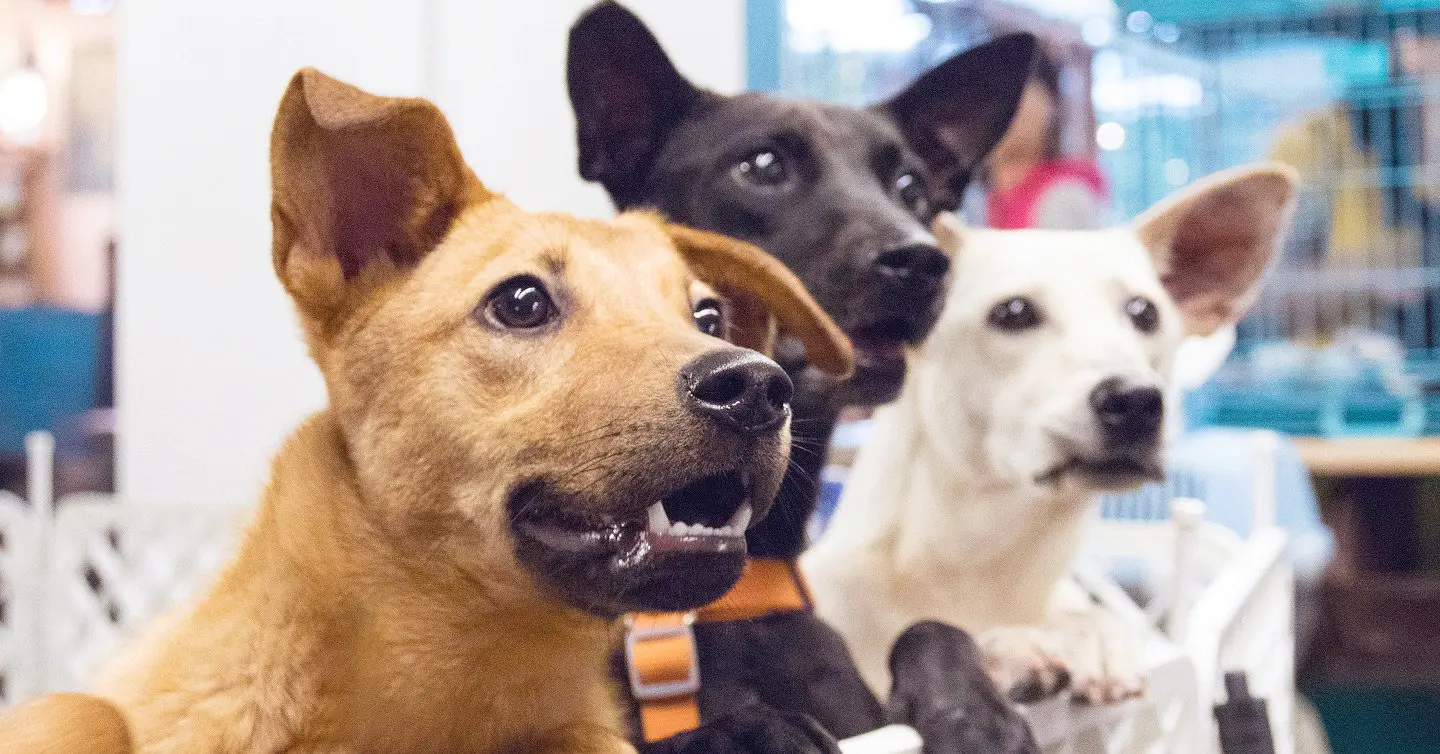Key Points
- Dogs can get injured from everyday play, fights with other dogs, and chance encounters with wildlife like porcupines.
- For minor wounds, you can provide first aid by controlling bleeding, cleaning the wound, and bandaging the area.
- Deeper cuts, heavy bleeding, infected wounds, and most puncture wounds will require professional veterinary care.
Dogs will be dogs — they explore, play, and chase after squirrels (sometimes head first into a thorny bush). While you can’t prevent every bump and scrape, you should still be prepared to handle basic wound care for your dog.
From scrapes and scratches to more serious injuries, every dog parent benefits from knowing how to clean and bandage wounds — and knowing when it’s time to go to the vet.
Common causes of wounds in dogs
No matter how careful you are, your dog will collect a few battle wounds just going about their daily life. And that’s okay — it’s just part of being a dog!
Common wounds in dogs are caused by:
- Accidents: Tumbles during roughhousing, outdoor activities, or household mishaps.
- Dog fights: Like humans, dogs can have disagreements leading to bites and scratches.
- Bites: Bites can also come from other animals and insects.
- Scratching and licking: Excessive scratching or licking may indicate underlying issues like allergies or skin infections.
- Surgery: Surgeries may leave incisions that require stitches, sutures, or staples.
- Foreign objects: Stepping on a sharp object, like glass, nails, or thorns.
Types of wounds in dogs
Understanding the different types of doggie injuries helps you confidently provide the right first-aid care for dog wounds and determine if a trip to the vet is needed.
- Abrasions (scrapes): Accidents can cause surface-level scrapes (aka the skinned knee of the dog world) that usually heal quickly by themselves.
- Lacerations (cuts): Lacerations are more serious cuts that go deeper into the skin and cause bleeding. If serious, open wounds on a dog can show muscle, tendon, or even bone.
- Puncture wounds: Little wounds caused by a sharp object penetrating the skin, including bug bites and other animal bites. While small, these wounds can penetrate deep and cause infections or muscle damage.
- Burns: These wounds cause redness, swelling, blisters, and pain deeper than the skin. Touching hot surfaces and harsh chemicals, chewing on electrical cords, or even sunburn can cause burns.
- Hot spots: Red, oozy patches of skin that pop up when your dog can’t stop licking, chewing, or scratching. Hot spots are often caused by allergies, parasites, and trapped moisture.
How to care for dog wounds at home
It’s impossible to shield your dog from all potential hazards, but knowing how to clean a dog wound goes a long way in unexpected situations.
It’s always a good idea to keep a dog first aid kit on hand to be ready. Here’s a quick rundown of what you’ll need:
- Sterile gauze pads or cloths
- Dog-safe antiseptic solution
- Pet-safe antibiotic ointment
- Bandages
- Scissors
- Tweezers
- E-collar
Always be careful when tending to an injured dog. A dog that’s injured and scared may lash out.
1. Stay calm and assess the situation
It’s scary and heartbreaking seeing your dog hurt, but it’s not the time to spiral. You need to remain calm and collected to use your best judgment and provide the best care for your dog. So, take a deep breath and assess the wound. Check the depth of the wound, the amount of bleeding, and your dog’s emotional state.
You can usually treat minor scrapes and shallow cuts at home. But for serious injuries — heavy bleeding that won’t stop, broken bones, persistent limping, deep wounds that need sutures, infected wounds, or potential internal injury — go to the vet or emergency animal hospital immediately.
Your dog’s emotions and behavior will also tell you a lot about the severity of the injury. Even if the wound doesn’t seem serious, if your dog is in extreme distress, head to the vet. Your pup may have internal damage that needs an accurate diagnosis.
2. Restrain your dog
Unfortunately, even the sweetest pup can become reactive when they are in pain. If your dog is anxious or in pain while you try to approach or check on the wound, they may become aggressive and bite.
While it’s important to tend to your injured dog, it’s equally important to protect yourself. Try talking to them in a soothing voice, gently restraining them using a leash, or putting a muzzle on them if needed.
3. Control the bleeding
When you see an open wound on your dog that’s bleeding, the first step is to stop the bleeding. Apply direct pressure using a clean gauze pad or cloth and maintain pressure for several minutes until the bleeding stops. If it doesn’t stop after 10-15 minutes, you should visit your vet.
If the wound is a broken nail (ouch!) use styptic powder to stop bleeding. Just dab a small amount onto the broken nail to help the blood clot quickly.
When possible, raise the wounded area above the level of your dog’s heart, as this can reduce blood flow to the injury. But if doing so causes your dog more pain, skip this step.
4. Clean the wound
The next step is to gently clean the wound with pet-safe antiseptic solution, cleaning solution, or clean water. This removes dirt, debris, and bacteria and prevents infection. Never use rubbing alcohol or hydrogen peroxide because they can actually cause more harm.
5. Apply ointment
For minor wounds, you can use triple antibiotic ointment, antimicrobial ointment, or silver sulfadiazine to help the healing process and prevent infection. A thin layer of antibacterial ointment to the wound is enough. Before applying any ointment, check with your vet for medical advice.
6. Bandage the wound
Wounds on your dog’s paws, legs, tails, or any area where they can easily reach should be bandaged to keep them clean and protected.
Apply a sterile bandage and non-stick pad over the wound to prevent the bandage from sticking to the skin around it. A self-adhesive elastic bandage also works great.
Wrap the bandage snugly enough to stay in place, but not so tight that it cuts off circulation. You should be able to slip a finger comfortably underneath it. If the bandage gets wet, dirty, or loose, it’s time to change it.
7. Monitor your dog
You’ve successfully dressed the wound and earned the parent of the year award in your dog’s eyes. Now remember to keep a close eye on the wound. Watch for any signs of infection, such as redness, swelling, discharge, or a foul odor.
If you notice any of these signs, or if the wound isn’t healing, call your vet right away. This may signify underlying issues that need veterinary attention.
When to see a veterinarian
Small scrapes and cuts can often be managed at home, but there are times when a trip to the vet is absolutely necessary. Here are the red flags you need to look for:
- Signs of infection: Observe for redness, swelling, pus, odor, warmth, fever, or lethargy.
- Deep wounds: Larger wounds that penetrate layers of skin or show muscle, tendon, or bone may need stitches.
- Heavy bleeding: Uncontrolled bleeding or significant blood loss requires vet care.
- Wounds near joints or on the face: These wounds have the potential for other complications like breathing difficulties, so let the professionals handle them.
- Bite wounds: Bites from other dogs or animals have a risk of infection or rabies.
- A distressed dog: If your dog seems distressed and exhibits unusual behavior, get them checked out by a vet.
- Stubborn wounds: The wound isn’t showing signs of improvement within a few days, or seems to be getting worse.
Unfortunately, emergency trips to the vet don’t always fit into your budget, and these unexpected vet bills can be a real pain. Having a pet insurance plan in place can help cover the cost of treatment for future accidents or illnesses. Learn more about how Pumpkin Dog Insurance plans can keep you focused on your pet’s care and not on the vet bill.

Long-term care for dog wounds
The road to recovery doesn’t stop after the initial first aid or vet visit. Sometimes, your dog may need long-term dog wound care for a smooth healing process.
Continued cleaning
Clean the wound with dog-safe antiseptic solution or wipes twice a day, or as directed by your vet. Gently pat the area with clean towels after cleaning to keep the wound dry and fresh.
Cone of shame (but for good reason)
Your dog may very well hate the cone of shame, but it’s for their own good. Elizabethan collars (e-collars) prevent your dog from licking or chewing the wound, and bacterial infection. If the healing process is long, a soft e-collar can make the process more comfortable.
Observe for infection
Watch for any signs of infection, and be ready to take your dog to the pet if the wound worsens. Early intervention prevents more serious complications.
Follow-up vet visits
Don’t skip follow-up appointments! Your vet needs to monitor the healing progress, remove stitches if needed, and make sure everything is on track. They’ll also guide you on activity restrictions, medications, and any lifestyle or living space adjustments.
Despite even the best efforts to keep your dog wound-free, accidents will happen. But don’t let this deter you from letting your dog live their best life. With the right care and prompt treatment, they’ll be back to zoomies in no time.
FAQs
- https://vcahospitals.com/know-your-pet/care-of-surgical-incisions-in-dogs
- https://beyondpets.com/pet-health-plus/traumatic-injuries-in-dogs/#lacerations-and-abrasions
- https://lortsmith.com/need-help-now/dog/injury-trauma/lacerations-cuts-in-dogs/
- https://vcahospitals.com/know-your-pet/first-aid-for-bleeding-in-dogs
- https://vcahospitals.com/know-your-pet/care-of-open-wounds-in-dogs
- https://bondvet.com/b/step-by-step-wound-care-for-a-dog-at-home-and-when-to-call-the-vet
- https://metro-vet.com/references/basic-bandage-care/
- https://www.petvet.vet/site/blog/2022/12/30/dog-wound-care
- https://www.broglilaneweaver.com/site/blog/2022/08/15/dog-wound-care-healing-stages




